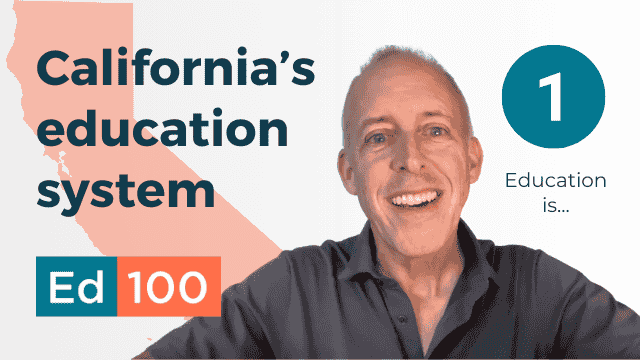
Few people really understand the massive California school system accurately — even in "normal" times.
In This Lesson

How big is the California school system?
Why should I understand the California education system?
Are California schools behind?
What is the Nation's Report Card?
What is the NAEP test?
Is the NAEP test fair?
Can demographics explain California's test scores?
How does California rank on test scores?
What are the key themes of Ed100?
Does Ed100 have a blog?
▶ Watch the video summary of Ch. 1
★ Hey, try the Ch.1 Discussion Guide
It's easy to think we know more than we do. After all, we lived through our own education, right? But a dose of humility is in order. The education system as a whole rarely changes much from one year to the next, but it changed quite significantly after the Great Recession of 2008, and again after the COVID-19 pandemic of 2020. Even in ordinary times, myths and outdated ideas have a funny way of sticking around.
Ed100 exists to demystify the California school system. Students have all kinds of different needs. To serve those needs and balance among them, the education system must be simultaneously massive and personal, which makes complexity unavoidable. To work for all students, it has to work for each student — even in a pandemic or a financial crisis. That's a significant challenge.
Let's start with the obvious: the system is really, really big.
|
California's Huge School Structures |
|---|
|
Millions of students. California is home to nearly 40 million people, including about 6 million students in K-12 grades. About 1 of every 7 people in California is a K-12 student. Each grade level enrolls roughly half a million students. |
|
Thousands of schools. There are about 11,000 schools in California — more schools than Starbucks. |
|
Thousands of teachers. There are more teachers than soldiers, doctors, lawyers, or police officers. California has about 320,000 teachers in K-12 alone. |
|
Billions of hours. Each K-12 student spends about 1,000 hours in school per year, for an annual collective total of 6.7 billion hours. For perspective, that's more than the cumulative hours spent over a decade to launch the Apollo mission. It's about 20 times greater than the total hours spent to build the pyramid at Giza. |
|
Billions of dollars. California has a giant economy. Expenditures for K-12 education account for about 3% of it. (This isn't impressive in context, which we'll discuss later, in Lesson 8.1. For now, the point is that the system is big.) |
There are sound reasons why this mammoth education system has to be particularly complex. Similar to Texas and Florida (and unlike, say, New York), California's population has grown and changed rapidly. The school system has had to grow and change with it.
Breaking it down
In California, about one student in five lives in poverty. About a fifth are learning English. Some kids come to school ready for kindergarten, but most don't. About an eighth have learning disabilities. All students need teachers that can teach complex material. And effective leaders. And access to the arts. Which takes money. And...
... and we're getting ahead of ourselves. Getting education right requires getting lots of things right at once. It's too much to think about everything simultaneously, so Ed100 breaks it down. It's easier to make sense of the system if you take it one topic at a time. Ed100 explains California's education system, busts myths, and explains what you need to know.
Wait, you might ask — do I really need to understand the system that governs California schools? Is it even possible? The answers are yes and yes.
Understanding the system is helpful for the sake of your own kids, of course, and the point of Ed100 is to make the system learnable. But there's something bigger: like it or not, you, as an involved parent or community member, are the heart of California's education accountability system. There is no independent watchdog in the system. You are it. The system literally depends on the vigilant support of local, active, informed constituents to speak up for what's right and what's needed.
To wield influence when you need it, you have to know what you are talking about. Ed100 can help with that.
California school results have improved a lot over the long term. But they are still pretty mediocre, and the pandemic hurt them.
Ed100's core content is a set of short lessons, including this one. (We have a blog, too, and a community toolbox.) You are reading Lesson 1.1, the first lesson of the first chapter. At the bottom of each lesson you will find a simple quiz that reinforces a main point. Pass a quiz and you earn a ticket (more about that in a moment); pass every quiz and you become an Ed100 Graduate.
You can do this. It's free, and it matters. If you complete all of the lessons you will become, in the words of one state leader, "intimidatingly well-informed." (She wasn't being tongue-in-cheek. Informed parents aren't easy to dismiss.)
Here's the main point of Lesson 1.1: California's K-12 educational results have improved a lot over the long term. But they are still pretty mediocre, and it's hard to argue that they have improved broadly in the last decade or so.
How can we tell if California schools are behind?
Schools serve many purposes, some straightforward and others hard to measure. Obviously, one of the central jobs of school is to help students learn facts and skills appropriate for their grade level.
Each year (with an exception in 2020 due to the COVID-19 pandemic) some of America's 4th and 8th graders take tests for the "Nation’s Report Card." To eduation insiders, these tests are known as the National Assessment of Educational Progress, or NAEP. (It's pronounced "nape.")
Very few children actually take the NAEP tests.
Only a few hundred thousand children actually take NAEP tests. These are not the tests that all students are required to take each year. (Those are called the CAASPP, or the "Smarter Balanced" tests.) NAEP is separate, and its purpose is meant to be diagnostic. As a federal service independent from state fiddling, it serves as a consistent yardstick of systemic educational success. Scores on NAEP, though imperfect, enable researchers and policymakers to monitor the overall education system, comparing student achievement between years, states, grades, and student subgroups (for example by race, ethnicity, or socioeconomic factors like family income).
NAEP scores don't tend to change quickly. Frankly, almost nothing in the education system changes quickly. Scores bump up or down a point or two, but the best predictor of next year's score tends to be last year's score. It makes sense, right? The education system is like an armada of giant ships, each rowed by thousands of little oars. Each year the people rowing have a lot in common with those who rowed the year before.
The underlying currents surrounding a school community tend to change slowly, too. Books and tools might change a little. Teachers evolve their lessons, or move, or retire, or shift grades. But on the whole, change tends to happen slowly.
There are exceptions.
In the pandemic, NAEP scores dropped and didn't immediately bounce back. School districts strained, with uneven success, to make access to technology universal. Teachers tried to figure out ways to make learning engaging at a distance, but it is increasingly clear that the cumulative work of learning was badly interrupted. In 2023, Stanford economist Eric Hanushek estimated that California's pandemic-era students will earn about 4% less in their lifetime as a consequence.
California's scores are low. And also ordinary.
California's children tend to score poorly on the NAEP tests. The chart below shows the overall rate at which groups of children in each state have scored at the level deemed proficient or better over time. (The chart averages fourth and eighth-grade math and reading proficiency rates. California is represented by the thick orange line. Full model here.)Unfortunately for California kids, these scores appear to matter. Education reporters often describe a ten-point difference in NAEP scores as representing about a year of learning. Some researchers dispute this rule of thumb, but if true, California's average students are years behind those in top-scoring states like Massachusetts. Meanwhile, California's less-advantaged students (those qualifying for free or reduced-price meals) are scoring a year behind less-advantaged students in Mississippi.
Why?
Perhaps these tests aren’t quite fair to California students. For example, administration of the test may vary a little by state. Some states provide extra testing time to English learners. Texas, for example, doesn't make students take the test if they are so new to English that they would bomb it. These small differences in administration probably matter a bit; small differences in state scores shouldn't be taken too seriously. Also, maybe the rule of thumb is wrong. Maybe ten points of difference on a NAEP test isn't equivalent to a year, but more like nine months. Or six. Anyway, tests don’t tell the whole story, right? There are many ways to measure success. And isn't Artificial Intelligence changing everything?
Year after year, the big picture is clear: California's students are behind.
These complaints and quibbles miss the point. The fourth grade reading assessment evaluates whether children can read short passages and understand them. The math questions are similarly basic. Year after year, the big picture is clear: California's students are behind.
Does it matter if California children start off slowly, one might ask, so long as they catch up later? Unfortunately, most don’t. For many years, research has shown that children who aren't reading at grade level by the end of third grade are at serious risk of never graduating from high school.
Are poor results somehow better for California, or for kids, if they can be “explained...?”
It's important to acknowledge that most of California's NAEP scores look less bad if you "disaggregate" them, comparing the scores of students with similar advantages and disadvantages. The Urban Institute shed light on this issue helpfully in 2019 in a still-relevant interactive report titled America's Gradebook. In 2024 the authors refreshed the analysis, but without the charts.
Yet another 2019 report, A Portrait of Educational Outcomes in California, pointed to the importance of family wealth. Kids in affluent districts in California tend to do well in school, like they tend to do everywhere. “The disparity between California and the nation is concentrated in average and disadvantaged districts where California students score nearly a full grade level behind their national counterparts. These patterns are consistent when the same comparisons are made within each racial/ethnic group.”
So... blame the kids?
Wait, some might ask — does this mean California’s lackluster NAEP scores can be explained by demographics? This question begs another in return: should it matter? Are poor results somehow better for California, or for kids, if they can be "explained" by the state’s larger numbers of children of color and children in poverty? Is it useful to imagine it as their fault? If we want California to have a bright future, can we afford to accept demographics as an excuse for low scores?
In any case, the data leave little room for denial. California’s children in poverty generally score starkly behind those in other states, as do California's Hispanic/Latino students. But California's white children aren't exactly leading the parade, either, and neither are California's better-off kids.
State-level results don't change quickly.
These results are not accidental or surprising. They do not tend to zigzag from one year to the next or change quickly in response to small changes in policy or practice. They are the long-term output of a large, complex system. In the 2022 and 2024 NAEP results, California's ranking improved mainly because other states did worse.
One important finding from the "Portrait" report mentioned above is that California's system has historically underperformed at each level. Gaps that start early are like educational potholes. If you don't fix them early they tend to get worse, not better. This is a national challenge, and perhaps a global one, but California has an impressively bad record at addressing it.
Themes of Ed100
As you read Ed100, a few themes will emerge, like these:
|
Some Themes of Ed100 |
|---|
| California's education system is massive, but education is personal. |
| Easy answers are tempting, but usually wrong. |
| For education to work well, many things have to work well at the same time. |
| Money isn't magic, but it can buy things that sure help. And a lack of money can really hurt. |
| Not everything of value in education is denominated in dollars. |
| Reforms have a shot at making a difference if they change who is in the room or how time is spent. (A Mockler maxim) |
| Prevention beats cure. |
| The long-term trends are almost all good. Better to be impatient than pessimistic. |
| People working in education almost always have good motives. Listen harder. |
| Punishment rarely builds capacity. |
| Public education ultimately relies on public will, measured in taxes. |
| Not all research is good research. Be suspicious of counterintuitive findings. |
| When in doubt, look at what rich families do for their kids. (A Mockler maxim) |
Perhaps you found your way to Ed100 because you want to help make things better. There are many approaches to change, and we will explore them one by one. It's important to lay the groundwork first, so let’s broaden the context a bit. The next lesson examines how California compares not just to America, but to the world.
Scroll down just a little more to take the quiz for this lesson. Pass it to earn your ticket and keep going to become an Ed100 graduate!
Updated March 2025
CHAPTER 1:
Education is…
-
Education is…
Overview of Chapter 1 -
California Education
Are California’s Schools Really Behind? -
American Education
Are U.S. Schools Behind the World? -
Education and the Economy
Schools for Knowledge Work -
Educational Failure
The High Social Costs of Bad Apples -
Grade Inflation
Wishful Thinking and Cognitive Bias -
Are Schools Improving?
Progress in Education -
History of Education
How have Schools Changed Over Time? -
Purpose of Education
What are Schools For, Really?
Related
-
American Education
Are U.S. Schools Behind the World? -
Are Schools Improving?
Progress in Education -
Education Spending
Does California Spend Enough on Education? -
Education Data in California
Keeping Track of the School System -
College in California
Options After High School -
Paying for College in California
Are College Loans Good For Students?
Sharing is caring!
Password Reset
Search all lesson and blog content here.
Login with Email
We will send your Login Link to your email
address. Click on the link and you will be
logged into Ed100. No more passwords to
remember!














Questions & Comments
To comment or reply, please sign in .
Carol Kocivar April 12, 2025 at 8:29 pm
"Since 1867, the National Center for Education Statistics (NCES) has collected data on American schools. That stream of information informs everything from funding services for students with disabilities to municipal planning to legal actions. But this information and other data and analyses from the Department of Education, which houses NCES, are now in danger of being cut off at the source... Canceling NCES contracts impacts our ability to understand the conditions and progress of schools toward meeting educational goals enshrined in laws like ESSA, IDEA, and the Equal Education Opportunity Act and mandated by court decisions like Lau v. Nichols,”
-- Bill Penuel, NEPC Fellow of the University of Colorado Boulder, via LinkedIn.
Carol Kocivar March 27, 2025 at 2:12 pm
"We count on the Department to administer national assessments and report the student outcomes. The Nation’s Report Card, also known as NAEP, has long been a critical tool to track the performance of our education system, provide transparency, and compare state performance. Without NAEP, we will not know to what extent children in Massachusetts are reaching the same standards of performance as children in Mississippi."
Jeff Camp - Founder March 18, 2025 at 8:59 am
Darla Williams February 24, 2025 at 11:50 am
Teresa Correa November 12, 2024 at 4:46 pm
David Siegrist1 April 28, 2025 at 3:44 pm
Yolande Beckles1 April 1, 2024 at 10:50 am
Ariel Locke November 22, 2022 at 9:24 am
Albert Stroberg September 26, 2022 at 12:28 pm
Jeff Camp - Founder October 7, 2022 at 9:58 am
Carol Kocivar July 5, 2022 at 3:15 pm
https://www.policyed.org/perspectivesonpolicy/overhauling-nations-report-card/video
Selisa Loeza October 22, 2021 at 11:33 pm
Peter McManus February 18, 2021 at 8:05 pm
Sonya Hendren June 30, 2020 at 3:41 am
I remember visiting the midwest at least 10 years ago and being surprised that all the students were issued laptops, when California didn't even do that yet.
Sonya Hendren June 28, 2020 at 10:35 pm
veronica clementel October 28, 2019 at 3:54 pm
Jeff Camp - Founder November 1, 2019 at 6:30 pm
Willem Vroegh1 September 9, 2019 at 9:09 pm
Jeff Camp - Founder November 1, 2019 at 6:32 pm
David Shahal April 26, 2019 at 9:02 am
Jeff Camp April 27, 2019 at 11:30 am
Minerva Zermeno March 11, 2019 at 11:48 pm
Jeff Camp March 18, 2019 at 3:52 pm
Namrata Mundhra February 25, 2019 at 8:11 am
Caryn February 25, 2019 at 10:55 am
Minerva Hernandez November 25, 2018 at 1:18 pm
Miela November 1, 2018 at 8:36 pm
Caryn November 6, 2018 at 12:57 pm
Eunice Su October 31, 2018 at 7:19 pm
Caryn November 6, 2018 at 12:54 pm
September 22, 2018 at 7:25 am
Caryn September 22, 2018 at 8:07 am
Sonya Hendren September 9, 2018 at 6:12 pm
Yes, I learned many things I didn't know before. But more importantly, ed100 put together, in a very organized manner, what had previously been very disjointed knowledge for me. As an interested parent, you learn snippets of this and that, here and there, but it doesn't have full context. Ed100 puts everything together. Its great for summaries with links where you can read more if you need the details on that topic. If you do the entire course, it's great for putting educational issues in context and giving a better sense of magnitude than "how often the topic appears in the news."
Caryn September 10, 2018 at 9:12 am
putneydog June 2, 2018 at 7:19 am
Jeff Camp June 5, 2018 at 10:36 pm
jacquelinebispo May 29, 2018 at 12:29 pm
Jeff Camp May 29, 2018 at 10:42 pm
Jeff Camp May 9, 2018 at 10:28 pm
Carol Kocivar April 8, 2018 at 2:07 pm
This new research suggests that money targeted to the needs of students, and allocated by local districts to meet those needs, can make a difference in student outcomes.
Read the report
August 1, 2017 at 5:46 pm
Carol Kocivar July 1, 2017 at 5:30 pm
http://caaspp.cde.ca.gov/sb2016/Search
In 2016, more than half of the students at almost every grade tested did not meet the California standards.
Caryn-C September 18, 2017 at 12:04 pm
Hari Titan September 8, 2018 at 11:35 am
Meilani Hendrawidjaja May 8, 2017 at 12:27 pm
May 3, 2017 at 11:13 am
Carol Kocivar December 29, 2016 at 3:39 pm
http://www.cde.ca.gov/ta/tg/nr/caresults.asp
Karen September 29, 2016 at 1:50 pm
Carol Kocivar October 15, 2016 at 11:44 am
Carol Kocivar June 12, 2016 at 5:40 pm
Take a look at where California ranks. Tip: Look towards the very bottom of the chart.
http://apps.urban.org/features/naep/?utm_source=June+10+digest+-+John&utm_campaign=Daily+email&utm_medium=email
The Village Method December 31, 2015 at 7:47 pm
Looking at our local performance levels in relation to the state-wide and national...seems to reveal more than what administrators are prepared to address.
jmjamiealita April 27, 2016 at 8:51 pm
brooke.blackmore November 4, 2015 at 8:08 pm
Jeff Camp - Founder November 6, 2015 at 3:28 pm
rxc2674 September 26, 2015 at 10:14 pm
hetds June 10, 2015 at 11:12 am
have terminated ALL PARENT EDUCATION CLASSES (aka Mommy and Me), I confidently predict even worse academic results for our students.
In our El Monte-Rosemead Adult School we have provided Parent Education classes since 1936.
Now, these classes have been liquidated in Adult Schools in CA.
How does this Parent Education Program work?
For three classes per week with three hours per class,
each child is accompanied for the entire class period by a caring adult. Under the guidance of an expert, credentialed Early Childhood Educator and an experienced Teacher's Assistant, the children ages two to four prepare academically, socially, and physically for Kindergarten.
This is truly class-size reduction as it should be.
Headstart, Pre-School, and Kindergarten Readiness have only one adult teacher (and sometimes an assistant)
To "teach" up to 25 kids. Is this possible?
Graduates from Parent Education Classes (which often include grandparents, aunts, uncles, adult siblings, and even caring adult neighbors) go on to success in K to college.
Yet, our state "leaders" decided to kill off
A proven educational program, which has so successfully
educated pre-schoolers and which prepare their adult family members to support these little ones throughout their schooling.
Also, the now defunct Parent Education Programs introduced immigrants, minorities, and the economically disadvantaged to how to succeed in school.
It's now gone, without any media coverage nor public discussion whatsoever.
bthiesen June 30, 2015 at 10:28 pm
Nivedita Sahasrabudhe December 15, 2018 at 11:47 am
omedina May 20, 2015 at 1:49 pm
arienneadamcikova April 20, 2015 at 9:50 pm
Jeff Camp - Founder April 20, 2015 at 11:40 pm
omedina May 20, 2015 at 1:43 pm
organodeflaco April 20, 2015 at 5:03 pm
jbrenee9 March 15, 2015 at 10:12 am
terirafiq March 15, 2015 at 10:07 am
Jeff Camp - Founder March 15, 2015 at 11:39 am
gwenhourihan March 11, 2015 at 9:55 pm
Jeff Camp - Founder March 12, 2015 at 10:57 am
harplits March 11, 2015 at 9:00 pm
ms March 3, 2015 at 4:23 pm
Jeff Camp - Founder March 3, 2015 at 5:16 pm
jenzteam February 27, 2015 at 6:12 am
Jeff Camp - Founder February 27, 2015 at 3:44 pm
melvill97 February 6, 2015 at 9:06 pm
anamendozasantiago February 5, 2015 at 4:35 pm
Jeff Camp - Founder February 5, 2015 at 6:29 pm
Emily RossBrown February 25, 2015 at 10:37 am
Jeff Camp - Founder February 26, 2015 at 9:48 am
EdMom March 8, 2016 at 11:56 am
amosmickey January 22, 2015 at 9:42 am
Jeff Camp - Founder January 22, 2015 at 9:16 pm
Sherry Schnell January 22, 2015 at 9:08 am
Jeff Camp - Founder January 22, 2015 at 9:27 pm
glendalearn January 17, 2015 at 10:33 am
1karenmcgarry January 16, 2015 at 4:42 pm
Jeff Camp - Founder January 18, 2015 at 2:17 pm
EdMom March 8, 2016 at 12:01 pm
mistaire November 8, 2014 at 1:53 pm
The real question here is what has (have) been done to address the issue, and why the awful result continue to be a constant for California.
Aude J. (an active parent)